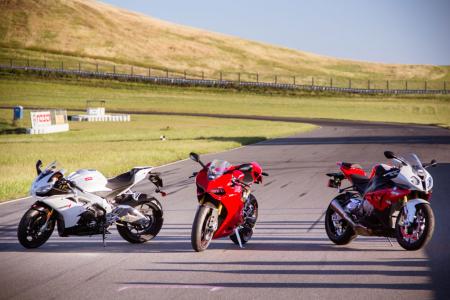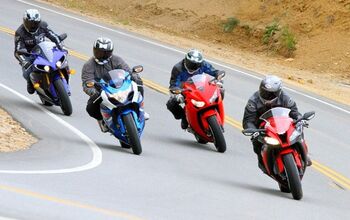2012 European Literbike Shootout Teaser - Video - Motorcycle.com
We’re hard at work conducting part two of our three-part literbike comparison test. This time it’s the exotics: Aprilia RSV4 R APRC, BMW S1000RR and Ducati 1199 Panigale S. We’re not finished yet, but here’s our first impressions about each bike after romping on them at the fantastic Thunderhill Raceway in Willows, California with our friends at Keigwins at the Track.
T-Hill is an eight-hour trek from our L.A. digs, but its thrilling layout of fast sweepers, long straights, technical hairpins and steep elevation changes make it one of the few places in the country able to let a literbike stretch its legs. Other than fitting each bike with Pirelli Supercorsa SC2 tires and disconnecting brake lights, our trio remained otherwise bone stock as you would find them on the showroom floor.
All three of our entrants are the cream of the crop in their respective manufacturer’s literbike lineup. All come with traction control and a quickshifter. The RSV4 is Aprilia’s premier sportbike, powered by a V-Four pushing 999.6 cubic centimeters. Sachs suspension bits don’t have the panache of the Ohlins gracing the Factory version but perform quite admirably.
We’ve gone on record in the past about the Aprilia’s sweet and nimble handling, and those attributes shine through remarkably around Thunderhill. In fact, being my first time at this track, I chose to ride the RSV4 during my sighting laps because its instant familiarity would allow my focus to be solely on line selection.
It didn’t disappoint. I still adore the Aprilia’s engine and chassis, and it’s a sentiment fellow cohorts Tom Roderick and Kevin Duke share as well. “Sweet, caramel-coated harmony,” says Roderick. “The Aprilia is the ultimate treat to ride on a racetrack.”
“Its balanced handling characteristics and obedient chassis remind me of the nimble CBR1000RR,” Duke remarks. “But its growling and thrilling V-Four gives it panache the CBR can’t touch.”
The 2012 BMW S1000RR, while not all-new, did get several small updates this year. There are slight tweaks in chassis geometry, electronic settings and outwardly appearance that, all told, left Duke gushing about the bike during its intro in Spain late last year. The monster engine seen on the original RR is back and untouched.
“Ferocious,” was the one-word description in my notes for the engine’s power and delivery. “You’ve got to hold on tight otherwise it will rip your arms off.”
While it’s by no means a large motorcycle, from the saddle the S1000 feels the most substantial of the three machines here. The transversely mounted Inline-Four spreads the rider’s knees further apart than the other two, and a well-padded seat combined with available heated grips serve to give the BMW a cushier feel.
All it takes is one twist of the throttle, however, to remind you of the bike’s intentions. Tom agrees, adding, “the S1000RR pilot is lulled into a state of serenity until cracking the throttle WFO down the front straight and arriving at turn one quicker than planned.”
The BMW is fast. It makes big power early in the rev range and doesn’t quit until its lofty 14,000-rpm redline. The RR is fastest down the straights, but we noticed the RR chassis to be slightly slower than the others when initiating turn-in or during side-to-side transitions.
Besides that it’s really quite hard to fault the BMW. Brakes are strong with good feel, and the tweaks made to the 2012 model add up to more than just hype. Hell, even the slipper clutch worked well. Added bonus: it’s also the least expensive of the lot at $15,050.
Then there’s the much-hyped Ducati 1199 Panigale. If this test were judged solely on anticipation, Ducati would win this contest in a landslide. It’s hard not to geek out over the myriad of features the new Duc has, and Duke covered them all in his first ride report from the Panigale’s launch in Abu Dhabi.
It’s important to note we’re riding the $22,995 S model Panigale in this test rather than the $17,995 base model we had requested. But we settled for the S version instead of waiting for the standard model because we wanted to be the first to bring you a test of the new Ducati on these shores.
After riding the Panigale, the common consensus among all three testers is that it’s unlike any production Ducati superbike ever made. It revs like a four-cylinder, handles with scalpel-like precision (more so than previous Ducatis) and has a mind-boggling amount of electronics. It’s not at all what we expect from Borgo Panigale, but we’re definitely not complaining.
Those with doubts of the semi-monocoque frame derived from MotoGP technology that failed Valentino Rossi and Nicky Hayden, we can put those fears to rest. There were a number of factors leading to the demise of Ducati’s GP machine, mostly related to the Bridgestone spec tire, which were completely irrelevant when designing the 1199.
“I knew from riding the Panigale at its launch it was a superb platform on the nearly bumpless Yas Marina Circuit,” Duke remarks, “And I was pleased to find out it also works remarkably well at a bumpier track. The Superquadro engine is surprisingy soft below 8 grand, but then it yanks up top unlike any V-Twin ever produced!”
In direct contrast to the BMW, the Ducati is extremely narrow – it feels like you could almost touch your knees together while sitting on it. The seat is hard and the Superquadro engine likes to sing, suggesting a racetrack focus, but oddly enough the pegs are surprisingly lower than we expected. Still, grinding hard parts while leaned over was a non-issue.
There’s no doubt the 1199 Panigale is a radical departure for Ducati, and only time will tell if the “defining engine characteristic endears itself to traditional Ducatisti,” says Tom. What we do know is all three machines are incredibly capable motorcycles for cutting quick times around a track. But we’re just skimming the surface.
Late next week we’ll be bringing you the entire 2012 European literbike shootout, complete with detailed track and street impressions, dyno figures, scorecards and much more. Stay tuned.
Related Reading
2012 Ducati 1199 Panigale Review – Video
2012 Ducati 1199 Panigale Preview
2012 Ducati 1199 Panigale “Superquadro” Engine Details
2012 BMW S1000RR Review – Video
2012 Yamaha YZF-R1 vs. 2011 Aprilia RSV4 R APRC – Video
2011 Kawasaki ZX-10R vs. 2011 BMW S1000RR Shootout
2010 BMW S1000RR Review
2010 Literbike Shootout: Aprilia RSV4 Factory vs. Ducati 1198S vs. KTM RC8R
2010 Aprilia RSV4 Factory Review
More by Troy Siahaan


































Comments
Join the conversation